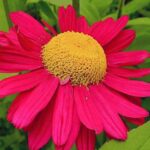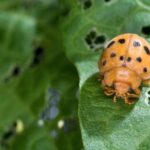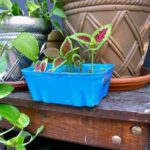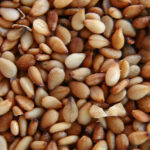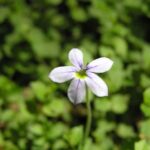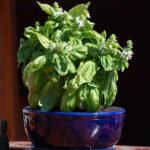We all know when leaves begin to get spotted, there’s a problem. While there’s a lot of causes of infected plants, today we’ll focus on one particular cause: anthracnose.
This fungal disease is widespread, affecting all sorts of plants from fruits and vegetables through grains, trees (both fruiting and non-fruiting), and ornamental plants. It is not generally fatal to every plant but can progress to become really bad. And it’s extremely common.
Let’s examine how to identify anthracnose disease, as well as how to treat it should it arise. But more importantly, we’ll talk about how to prevent it in the first place. Prevention is always the best line of defense! Once you know how to control anthracnose, you’ll have no problem preventing it issue in the future.
Anthracnose Overview
| Common Name(s) | Anthracnose, anthracnose leaf spot, anthracnose blight, anthracnose basal rot, anthracnose fungus |
| Scientific Name(s) | Colletotrichum gloeosporioides, Colletotrichum coccodes, other Colletotrichum species, Apiognomonia veneta, Apiognomonia errabunda, assorted other Glomerella species, and assorted other Gnomonia species |
| Family | Glomerellaceae, Gnomoniaceae |
| Origin | Worldwide |
| Plants Affected | Extremely wide range including trees, fruit/vegetables, cereal crops, ornamental plants, and turf grasses |
| Common Remedies | Control anthracnose with neem oil, Bacillus subtilis, sulfur dust fungicides, liquid copper fungicides, plus a number of care methods that promote healthy plants |
What Is Anthracnose?
The term “anthracnose” is used to describe a particular set of symptoms caused by an entire genus of fungi. The Colletotrichum genus is the source of most anthracnose-based symptoms.
Likely the best-known of these fungi is Colletotrichum gloeosporioides, a particularly problematic species that impacts hundreds of plant types. It causes damage to grasses and cereal crops, fruits and vegetables, legumes, perennial crops, and trees.
While C. gloeosporioides does a lot of the damage, anthracnose fungus is not limited to that one fungal species… or even to that one genus.
Tomato anthracnose is caused by Colletotrichum coccodes, as an example. Sycamore anthracnose, however, is caused by Apiognomonia veneta, a completely different fungal genus. Same goes for ash trees, which are affected by the fungus Gnomoniella fraxini.
There’s quite a few different causes, but thankfully the treatment for anthracnose fungus will be similar despite different fungal causative agents.
Life Cycle Of Anthracnose
Like most fungal diseases, anthracnose diseases propagate via spores, mostly on infected leaves. Once a host is infected, it will produce spores that can be distributed by the wind, rapidly spreading from plant to plant. They may also drop into the soil and be distributed via water splashed onto other plants.
Once these spores find a host, the disease spreads rapidly through the plant, causing damage to leaves, stems, and fruit. It can overwinter in plant debris or soil and may infect seeds so that it redistributes through next year’s planting. Most of its damage occurs in spring and early summer.
As the weather conditions heat up, anthracnose symptoms rapidly reduce. When the weather is regularly hot, the fungal progress slows and stops altogether. However, it may return when the weather cools back down. What’s difficult about the disease is it is active in the growing season of many food crops.
Wet, mild seasons are when anthracnose is at its most prevalent, and also when symptoms spread the fastest. Keep a watchful eye out in both the spring and fall growing season for symptoms of anthracnose infection.
Symptoms of Anthracnose
Since so many types of plants can be damaged by anthracnose, the symptoms vary dramatically. We’ll go over some of the most common signs of anthracnose infection here.
Early Anthracnose Detection
In infected leaves of turf grass or on your average homeowner’s lawn, anthracnose can be seen early as patches of yellowed grass. These can be easy to pull out but may be dappled throughout the lawn.
For most vegetables and fruit, anthracnose initially shows up as small spotting on the leaves, stems, or fruits. These spots can be yellow, brown, or black, as the spotting itself will age and develop.
Cereal crops like wheat may have streaking on infected leaves rather than spotting, but it will be patchy and typically yellow in coloration when first becoming established.
Shade trees and other large trees that are susceptible to anthracnose will also develop leaf spotting early on. Especially young leaves and young twigs which are affected may twist or become deformed. Ripening fruits may become spotted and damaged during this phase. This is why early detection and effective anthracnose control is important.
Evergreen trees infected with early stages of anthracnose fungi show light yellow spots on the leaf surface that eventually spread out giving the leaf a mottled appearance.
Later Anthracnose Progression
Over time, turf grasses will turn to a rusty red-brown color as the leafy portion succumbs to the fungal infection. Anthracnose can also cause basal rot in grass, causing the roots to rot away and die off.
Fruits and vegetables may develop dark, sunken lesions along the stems or on the fruit. Spotting will continue to darken to a black color and may take over an entire leaf or branch surface. Over time, the blackened spots may completely fall out, leaving holes in leaf surfaces.
These lesions will develop into fruit rot on the fruit, but if the plant is strong and healthy otherwise it should survive with proper care. Fruit rots may look pinkish and sunken and may have spore masses on the surface.
In cereal crops such as wheat or corn, top die-back may begin to occur. This can continue even through the hotter months of the year. Lesions may appear on the stalks and may develop into stalk rot.
Bad infections in trees can cause premature leaf drop, sometimes completely defoliating an affected tree. Cankers may appear on branches or leaf ends, and may also cause girdling of the trunk. Fruit may experience rotting and extensive spotting. This can make way secondary pathogens to infect your plants via open wounds and insect feeding.
If new growth appears after anthracnose infection, tree branches and leaf growth may be twisted or knotted in appearance. While most trees will survive through mild anthracnose infections, severe ones can cause lasting damage to the tree.
Evergreen trees and large trees which have later stages of infection experience the death of leaf tissue. This can be dangerous to some in seasons where surface area is necessary for nutrient absorption and processing. If you notice these symptoms, it’s time to learn and practice methods to control anthracnose.
Controlling Anthracnose
Now that you have a grasp on what anthracnose will do to your plants, let’s talk about how to treat anthracnose disease. We’ll also go over prevention techniques that you can use to stop it before it takes hold.
Anthracnose Treatment
Let’s begin with an all-purpose treatment. Neem oil can help prevent this fungal disease from developing on the surface of leaves or stems. It also reduces the population of aphids and other pests which may inadvertently carry spores to your plants, so it’s wise to use it anyway!
Another good product that can help prevent fungal disease is Serenade Garden. This product is an organic fungicide that uses Bacillus subtilis to kill off fungal growth. It’s quite effective against most strains of anthracnose.
A sulfur dust fungicide may also be a good choice for you. It can be used to dust leaves dry, or can be mixed with water and sprayed onto the plants. Sulfur does have a distinctive aroma, but it works quite well to deal with fungal infections.
If the above three don’t help, you may want to consider using a liquid copper fungicide to control anthracnose. I’m partial to Monterey Liqui-Cop, but other liquid copper blends will also work. This handles many diseases which attack the young twigs of trees, vegetables/fruit, and ornamental plants.
The methods above will also work for lawns as well as most trees, vegetables/fruits/grains, or ornamental plants. If necessary, there are chemical turf fungicides that are easy to dispense, too. Just be cautious with these around children and pets.
If you’re concerned with fruit that might be prone to developing diseased areas, you can do a post-harvest sterilizing dip in hot water. Your water should be at least 125 degrees Fahrenheit, and the fruit will need to be completely submerged in it for at least five minutes.
However, this may partially cook the outside layers of the fruit, so while it does prevent some forms of storage rot, it may be easiest to just watch for potential rot signs and weed out damaged fruit at that time.
Preventing Anthracnose
As I said earlier in this piece, the best defense against these fungal diseases is prevention, so let’s talk about all of the ways you can prevent anthracnose from taking control.
Keep a well-maintained yard and garden. Cleaning up plant debris, like fallen leaves and infected twigs from trees, consistently ensures that the fungi don’t have a location to overwinter. It also ensures that any spores that may have developed are cleared out, hopefully before they infect the soil.
Space your plants and keep them pruned to allow for good airflow. This is especially important in the spring and fall months when a little rain can easily create conditions perfect for fungal development.
When pruning, maintain good sanitation between cuts, and wash your hands between plants. Ensuring your tools and hands are spore-free will protect the next plant in line to be trimmed.
Water using an irrigation system that doesn’t directly spray the plants or cause splashback of soil onto the plants. If there are any fungal spores in your soil, the splashback can get them up onto the plant where they can take hold, so this is an important step.
Similarly, to practice base anthracnose control, keep ripening fruit off the soil’s surface as it’s growing to prevent fungal growth in the fruit itself.
The healthier that your plants are, the more likely they will resist the symptoms of anthracnose. Keeping them fertilized properly and increasing the soil quality will help your plants to thrive and hold off infection.
Planting resistant or tolerant species and certified disease-free seed will give you a better chance of holding off infection as well. While resistant species may still have some damage from fungal disease, they are better able to survive despite any damage, as opposed to highly susceptible species.
Finally, proper crop rotation can help reduce the likelihood of fungal spores building up in the soil and causing damage to your plants.
Frequently Asked Questions
Q: Can you eat tomatoes with anthracnose?
A: Anthracnose creates sunken masses on tomatoes, many of which will develop spores. You can cut these portions of the tomato out (including a good margin of healthy flesh around the damaged part) and still eat the rest, but be sure that you throw away the diseased portion. Don’t compost it, as spores may contaminate your compost.
Be forewarned, even if you harvested what looked like tomatoes, plants that have anthracnose may still have passed on that potential to the plant. The fruit can still develop sunken patches and spore growth as it ages on the counter. Cut out any damaged parts before using!
If you have any concerns about the diseased portion and how far it reaches, there’s an old saying which applies: “If in doubt, throw it out.”
Q: What is the best way to treat anthracnose?
A: With any plant disease, prevention is the most effective treatment. However, if you’re beyond the ability to anthracnose control via prevention, use neem oil, or organic fungicides to treat the disease. Remember to avoid spraying these when beneficial insects are at peak activity, and limit spraying times to shortly before dawn.
Q: What is the cause of anthracnose?
A: Most forms of this disease are caused by fungi in the Colletotrichum genus. These fungi are most prolific in temperate weather conditions and moist environments, most often during the peak of the growing season. They get onto plants via infected soil, fallen leaves from infected plants, and splashing from nearby irrigation.
Q: What are the symptoms of anthracnose disease?
A: Because the disease affects so many plants, the symptoms vary widely. Anthracnose in general presents itself as varying leaf spots and blights.
Q: Does anthracnose go away?
A: In hot, dry weather, anthracnose activity slows and can become dormant. You can also use varying organic fungicides to wipe out the fungus. Pair that with sanitary garden practices and you can prevent future infections.
Q: What fungicide kills anthracnose?
A: The safest and most effective fungicide for this disease is Bacillus subtilis. If possible, quarantine your plant to prevent beneficial insects from ingesting tissue that could harm them.
Q: How can anthracnose be prevented?
A: Good garden practices are the main form of prevention. This means keeping it and your garden tools clean, removing fallen leaves from infected plants as necessary, and practicing proper irrigation techniques. You can also remove damaged plants and plant matter to keep future infections at bay.
Q: Can a tree recover from anthracnose?
A: Many plants infected with anthracnose fungus have no trouble recovering assuming they are already healthy plants. This goes for trees too – shade trees and fruiting ones. They defend themselves via defoliation (known commonly as leaf drop) before the disease can penetrate too deeply into their tissue. You can still practice anthracnose control and prevention if a tree is infected, though.



